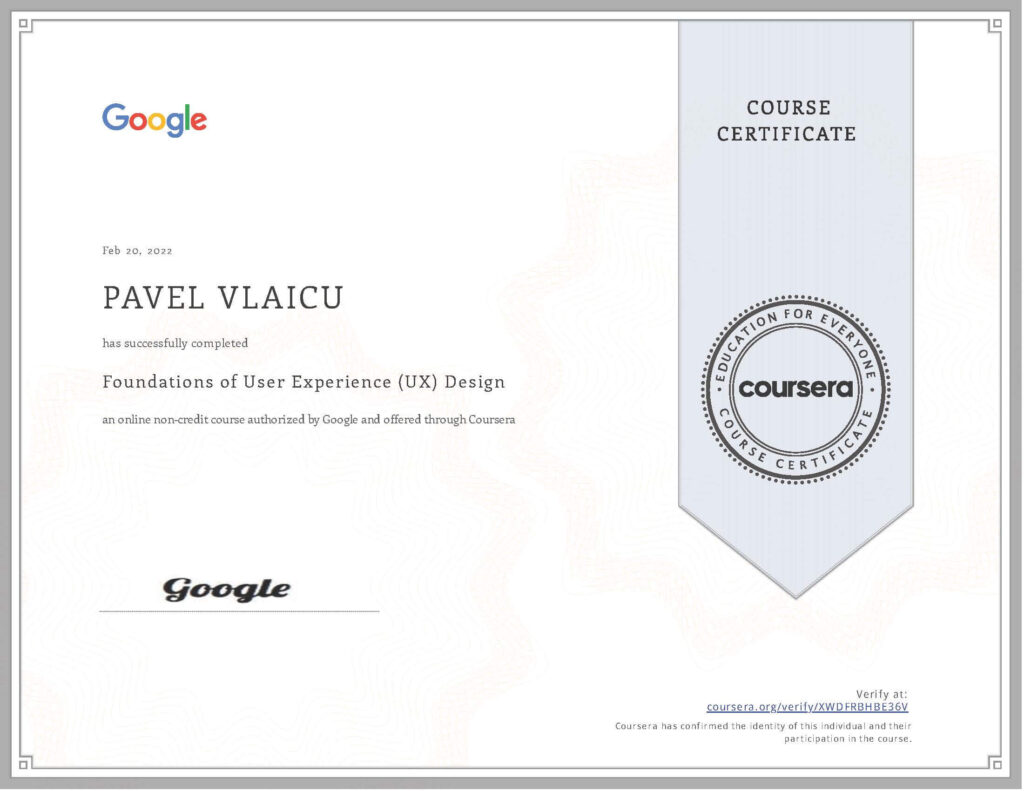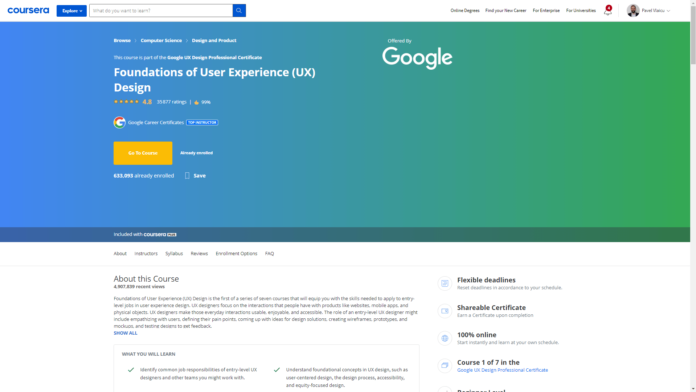About this Cours
Foundations of User Experience (UX) Design is the first of a series of seven courses that will equip you with the skills needed to apply to entry-level jobs in user experience design. UX designers focus on the interactions that people have with products like websites, mobile apps, and physical objects. UX designers make those everyday interactions usable, enjoyable, and accessible. The role of an entry-level UX designer might include empathizing with users, defining their pain points, coming up with ideas for design solutions, creating wireframes, prototypes, and mockups, and testing designs to get feedback.
Current UX designers and researchers at Google will serve as your instructors, and you will complete hands-on activities that simulate real-world UX design scenarios.
Learners who complete the seven courses in this certificate program should be equipped to apply for entry-level jobs as UX designers. No previous experience is necessary.
By the end of this course, you will be able to:
– Define the field of UX and explain why it’s important for consumers and businesses.
– Understand foundational concepts in UX design, such as user-centered design, the design process, accessibility, and equity-focused design.
– Identify the factors that contribute to great user experience design.
– Review common job responsibilities of entry-level UX designers and teams that they work with.
– Explore job opportunities and career paths within the field of user experience.
– Explain why design sprints are an important and useful part of a UX designer’s work.
– Describe common UX research methods.
– Identify and account for biases in UX research.
What you will learn
Identify common job responsibilities of entry-level UX designers and other teams you might work with.
Understand foundational concepts in UX design, such as user-centered design, the design process, accessibility, and equity-focused design.
Explain why design sprints are an important and useful part of a UX designer’s work.
Skills you will gain
User Experience (UX)
UX Research
Wireframe
Prototype
User Experience Design (UXD)
Instructor
Google Career Certificates
Offered by
Google Career Certificates are part of Grow with Google, an initiative that draws on Google’s 20-year history of building products, platforms, and services that help people and businesses grow. Through programs like these, we aim to help everyone– those who make up the workforce of today and the students who will drive the workforce of tomorrow – access the best of Google’s training and tools to grow their skills, careers, and businesses.
Syllabus – What you will learn from this course
Week 1
Introducing user experience design
User experience (UX) designers focus on the experience that users have while using products like websites, apps, and physical objects. UX designers make those everyday interactions useful, enjoyable, and accessible. In the first part of this course, you’ll be introduced to the world of UX and the factors that contribute to great user experience design. You’ll understand the job of a UX designer and teams that UX designers often work with. You’ll also get to know more about the expectations of the Google UX Design Certificate.
Week 2
Thinking like a UX designer
UX designers always put the user first. In this part of the course, you’ll be introduced to user-centered design and one of the design frameworks that UX designers use on the job. You’ll also learn about design best practices, including the importance of inclusive design and accessibility when designing. In addition, you’ll learn how to think across platforms to design seamless user experiences.
Week 3
Joining design sprints
UX designers often participate in design sprints to define the direction of a product. In this part of the course, you’ll explore the world of design sprints, including the phases of a design sprint and how to plan and participate in one. You’ll also learn about retrospectives, which is a way to constructively reflect on a design sprint and identify areas of improvement to implement next time.
Week 4
Integrating research into the design process
As a UX designer, it’s your job to put the user front-and-center in everything you do. In this part of the course, you’ll explore the role of research in the design process to help you better understand and empathize with users. You’ll also learn about the benefits and drawbacks of common UX research methods. And, you’ll identify and account for biases that can arise when conducting research.

